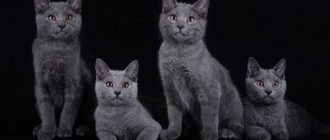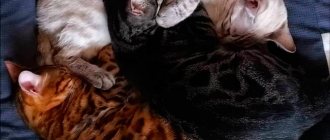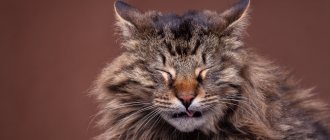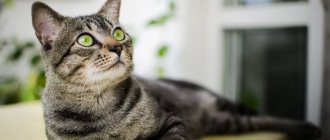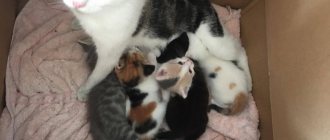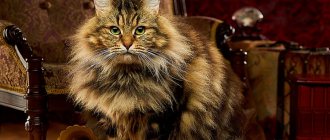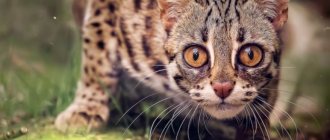Origin story
Somali cats are a young breed, but extremely popular.
And no wonder: just look at this fluffy reddish miracle with big eyes - and love at first sight is guaranteed. The “official” year of birth of the breed is 1972: it was then that the “Somali Cat Fanciers Club” opened in the United States of America with great fanfare. However, if you dig deeper, it becomes clear that the story began to develop much earlier. In the 40s of the 20th century, in the litter of the Abyssinian cat, kittens appeared different from the rest: they had the same shape of eyes and ears, a tail typical for the breed and the structure of the paws, but the hair was not short, but long, soft and silky.
A breeder named Janet, considering what happened to be a marriage, decided to profit from this as well. The kittens were successfully sold. After some time the situation repeated itself.
It is worth noting that after the Second World War, the Abyssinian breed was in danger of complete extinction, and breeders began to cross them with breeds that were as similar as possible in type and physical characteristics. There were also long-haired ones among them.
In the 60s, Evelyn Magyu's cat gave birth to the same “shaggy” kittens. It can be assumed that the genes of Janet Robertson's cats got into Evelyn's animals, but, unlike the latter, Mague was more attentive to her pets. It was she who decided to give the green light to the new breed, naming it after the African country. Why Somalia, they asked Evelyn. She explained simply: the closest neighbor of ancient Abyssinia is the state of Somalia. Do you get the connection?
At first, Evelyn’s path was full of obstacles: many Abyssinian lovers spoke out against the new breed, fearing competition. However, Evelyn was also stubborn. The breed was registered.
In 1979, it was recognized by the CFA organization, followed by other major European associations. In the end, the International Cat Federation also put an end to recognition.
Story
Until the mid-20th century, the history of Somalia was inextricably linked with the shorthaired Abyssinian cat. For thousands of years they coexisted as one breed in northwest Africa under the name “Zula”.
In the 19th century, the animals were exported from Ethiopia, which at that time was called Abyssinia, which gave them a new name. During World War II, the population declined sharply, leaving only a dozen Abyssinians in the world. Active restoration in the 1950s was carried out by Janet Robertson, who distributes kittens around the world.
Independently of each other, kittens with long hair are born in the USA, New Zealand and Great Britain. It is still not clear what caused the occurrence; there are two versions.
According to the first, crossbreeding took place: since the population was severely damaged by the war, it is possible that breeders used long-haired cats to restore them.
The second theory is more popular among breeders because it means the Somali is of natural origin. The gene responsible for long hair is recessive. It could have existed for thousands of years and manifested itself thanks to the presence of carriers among the last Abyssinians.
Long-haired kittens were considered defective, and breeders got rid of them, as this put a stain on the Abyssinian pedigree.
Somalia was saved by a miracle. American Evelyn Magyu discovered a long-haired kitten in the litter, which was dealt with in the traditional way - given away as quickly as possible. After some time, an adult and unusually handsome Somali, George, was found on the street and taken to the shelter owned by Evelyn. Having recognized the very same cat in the long-haired handsome man, the American woman decided to restore justice and announce a new breed to the world.
The name was chosen in honor of the country neighboring Ethiopia - Somalia.
At first, Abyssinian breeders resisted the appearance of Somalis, not allowing them to attend exhibitions. However, over time, the “war” faded away. By 1980, Somalia was recognized by US associations, and in 1991 it received GCCF champion status. Despite their “dark” origin, these cats have gained recognition due to their beauty, behavior and intelligence.
Standards
Males are larger in appearance than cats, and they weigh more: 4-5 kg versus 2.5-4. The chest protrudes forward, the spine bends. Height – approximately 30 cm.
| Standard | Description |
| Head | Wedge-shaped head and muzzle with smooth, smoothed features. |
| Ears | Wide at the base, medium in size, with pointed tips and tufts of hair inside. The standard also allows tassels on the tips. |
| Eyes | Large, almond-shaped, bright, rich color (yellow or green). Outlined in black. |
| Limbs | Graceful and slender, proportional to the length of the body. The paws are oval, the pads are compact, “matched”. There are 4 toes on the hind legs and 5 on the front legs. |
| Tail | Thick and very fluffy. Outwardly it resembles a fox. Tapers towards the tip. |
| Torso | Compact, muscular, with strong bones. The neck is powerful. |
| Wool | Ticked, medium in length. In the area of the panties, collar and tail it is thicker and longer. The undercoat is thick, the guard hairs are soft and thin. |
Breed defects:
- Extra fingers (or lack of fingers);
- A tail with a squiggle at the end;
- Stripes, spots, or a choker pattern on the neck;
- White spots on the head or body (exception: chin and nostrils);
- Brown hairs at the roots.
Somali is a long-haired cat descended from the Abyssinian, description, care and cost
The Somali cat is a breed that combines such qualities as activity, intelligence, peaceful character, friendliness and sociability. Cats love to play, so they get along well with children.
History of the breed
There are several versions of the origin of the breed. It is believed that the first Somalis descended from the Abyssinian cat as a result of a genetic mutation - the appearance of the gene for long hair. According to another version, the Somali is a breed that appeared as a result of crossing a mongrel long-haired cat with an Abyssinian.
Somali cat
For the first time, cats similar to Abyssinians, but with a long shiny coat, appeared in New Zealand, Canada, Australia and the USA. At that time, such animals did not arouse interest and were considered defective representatives of the breed.
Cat breeding began seriously in the second half of the 20th century. In 1963, a strange Abyssinian with long hair appeared for the first time at a Canadian city cat show. Its breeder Mary Meiling teamed up with other Canadian felinologists (Don Richings and Ken McGill) to create the first nursery.
Somali cat
The young breed received official recognition from the European organization CFA only in 1978.
In 1979, the Somali cat won the CFA championship title for the first time, and in 1991 the GCCF championship title. A year later, the Somalis were brought to Europe, and a nursery for breeding cats was created in France. In 1982, a significant event took place in the history of the breed - it was officially recognized by the International Organization of Cat Fanciers.
Appearance and standards (colors)
The latest Somali breed standards were published in 1999. Characteristics of the representative given by the CFA (Cat Fancier Association):
- The head is medium in size, slightly rounded, wedge-shaped.
- The forehead is relatively large, with a soft contour. The transition to the ears, eyebrows and neck is smooth.
- The muzzle is wide, the chin is full (bite defects are not allowed). The muzzle should not be pointed (fox muzzle defect). Only adult cats are allowed to have tufts of fur on their cheeks.
- The ears are set wide on the head, moderately pointed at the ends, widening towards the base in a cup-shaped manner. Tufts of hair (preferably directed downwards) grow in the inner surface of the ear.
- The eyes are large, almond-shaped, expressive. The eyes have a dark rim, light circles around them and dark stripes on the borders of the light fur. Eye color – all shades of green (preferably light green) and yellow (preferably amber).
- The body is medium in length and size, flexible and graceful. The chest is slightly rounded and the back is arched. The build is average (between thick and thin) with well-developed muscles.
- The limbs are proportional to the body in width and length, graceful and strong. Paws are oval, medium size. The front paws have five toes, the hind paws have four.
- The tail is long, heavily pubescent (“broom” - the hairs hang down). Wide at the base, slightly tapering towards the tip.
The Somali cat has either a desirable or undesirable color type.
If you carefully examine the hairs of Somali cats, you will notice that they are colored not in a single color, but in stripes. Ticking, or agouti, is a rare variant of coat color that involves alternating light and dark stripes. According to breed standards, there must be at least two such stripes on each hair of a cat.
Be sure to read:
Description of the Chinchilla cat breed - character, habits, hygiene and grooming of this beauty
Somali cat
Undesirable colors include cool shades:
- silver (white and silver ticking stripes);
- blue (gray and blue agouti stripes);
- sand (predominance of yellow, sandy shades);
- ash (gray and black ticking stripes).
The following are considered desirable (correct) colors:
- wild, or Ruddy, or rabbit (ocher and red stripes of agouti);
- classic sorrel (stripes of rich shades of copper, red, apricot and brown);
- warm blue (a bizarre combination of gray, apricot and dark yellow tones);
- fawn (a rare color that combines a lilac top and a creamy red base);
- silver sorrel (a combination of chocolate, silver, white and pale red).
Acceptable colors are based on ticking! Compared to the Persian breed, where almost all patterns on the coat are allowed, the requirements for Somalis are more stringent. Cats of other color types are disqualified from competition.
The following colors are not acceptable:
- monocolor (one color);
- bicolor (a combination of two colors) and other subspecies of piebald colors (calico, harlequin, medallions, “socks”);
- tortoiseshell (a combination of three or more colors, patterns);
- stripes (brade, mackerel, oyster or brindle) and spots (tabby, leopard, mink or rosette);
- all types of points.
The disadvantages are:
- continuous white necklaces or their presence is too clear;
- paw rings;
- white spots in the groin area and in areas other than the chin, nostrils, eye rims and upper throat;
- black hair roots.
Habits and character of Somali cats
Somali cats are energetic: they prefer to spend time in active games.
Somalis need space where they can run and climb to their heart's content. The claws of Somalis are very tenacious: they easily hold objects. Cats of this breed happily get along with other pets.
Somalis are not afraid of water. Not only do they tolerate water treatments calmly, but they can also play with the stream of water or lie in the sink. It is better to accustom an animal to water from childhood.
Be sure to read:
The Norwegian Forest Cat is also similar to the Siberian cat, Turkish Van and Maine Coon
Somali cat
A distinctive feature of the Somali cat is its intelligence.
Animals are easy to train, quickly learn rules, obey their owner and are able to subtly sense his mood. If you wish, you can teach your Somali cat a few tricks.
Pets should not be left alone for long periods of time. Somalis need communication and affection, and therefore will be very bored if no one is near them.
Unlike the independent Abyssinians, with whom they like to compare Somali cats, the latter do not like to walk.
Features of the content of Somalia
Somali kitten
Keeping Somali cats does not require much effort from their owners. By nature, the animal has good health and immunity. It is important to take into account the recommendations of felinologists regarding nutrition and care, and then the pet will feel comfortable.
Hygiene
You need to wash your Somalia as needed: the cat does this perfectly well on its own. Once a month you need to bathe your pet with a special shampoo.
It is very important to wipe the ears and eyes as they become dirty with a damp cotton swab. The procedure will prevent infection.
Care
Somali cat
The Somali has a semi-long or long coat, with a thick undercoat. Combing is necessary to prevent tangles, remove dead hair and maintain healthy hair.
For the procedure you will need a slicker brush, a regular comb and a brush-mitten. Combing 2-3 times a week is enough. When your cat begins to shed, you need to brush it every day.
To take care of its claws on its own, your cat will need a scratching post.
Nutrition
You can feed Somalia with both natural food (raw and boiled meat, cereals, boiled eggs, low-fat cottage cheese) and special food. It is necessary to choose high quality food intended for long-haired breeds.
Health and life expectancy
Somali cat
A hereditary disease that affects some representatives of the breed is extremely rare: amyloidosis and pyruvate kinase deficiency. Allergies, defects in vision, hearing and skeletal structure are not typical for this breed.
Be sure to read:
Balinese cat - the breed originated from the Siamese, photo, character and cost
On average, Somali cats live 12-13 years, while maintaining natural activity for many years.
Castration and sterilization
Cats are castrated at the age of 6 months: then they begin puberty. The operation is carried out to prevent the pet from marking territory, screaming and becoming aggressive. Cats are sterilized later, at 7-8 months.
Breeding and mating
Somali cat
Breeding Somali cats is quite a profitable business. The breed is popular, which means there is a demand for kittens.
Criteria for choosing a partner
To choose a partner for your pet, pay attention to the following aspects:
- Pedigree. A kitten from titled parents will cost more and have the right traits.
- Vet passport. It must indicate all vaccinations and indicate all diseases (if any) of the animal.
- Age. It is advisable that the prospective partner be young.
At what age should you give your pet for the first mating?
In cats, sexual activity begins at 6 months, in cats - at 7-8 months. It is better to wait up to a year so that the first mating and subsequent births go smoothly.
How often can a Somali cat give birth?
A cat's pregnancy lasts about three months. Veterinarians advise breeding cats (if necessary) at least through estrus, i.e. once every two years. This way the body will recover after pregnancy, and the mother cat will have time to feed and raise the kittens.
Purchase rules
The rules for purchasing Somali cats are standard. Check the pedigree of the kitten’s parents and the presence of a veterinary passport.
Choosing a kitten and the price of Somalia
Somali kitten
It is better to choose kittens personally. When meeting and directly communicating with an animal, you can assess its condition, compliance with standards, health and character.
The price for a kitten is about $300. An adult cat costs more (up to $2,000).
Where can I buy it?
Kittens are sold:
- in specialized or combined nurseries (more expensive, but with a pedigree, passport and vaccinations);
- by hand (risky, often without documents, but cheaper).
Pros and cons of the Somali breed
Somali cats are friends for active people who love communication and games. Pets get along well with children and other animals. Somalis are smart and understanding.
The only disadvantages of the breed include excessive activity and playfulness.
Colors
The “highlight” of Somali cats: ticking, i.e. alternating 2-3 colors on one hair. The standard allows 4 colors:
Fawn (roe deer)
Fawn (roe deer) is a combination of light peach and cream. At the roots, the hairs are dyed a light beige shade. The main requirement is uniformity of color.
Sorrel (copper)
Sorrel (sorrel, copper) - copper with a red tint or light brown with an apricot base. The tips of the ears and tail are brown, the paw pads and nose are pink.
Blue
Blue - at the base the coat is colored light cream or light beige, and closer to the surface - smoky blue. The paw pads are the same.
Ruddy (wild)
Ruddy (wild) - brownish-red or red wool. The tips of the hairs are colored black, and a dark stripe stretches along the spine and to the tip of the tail. The paw pads are also black.
The above colors are recognized by all felinological organizations, but colors such as lilac and chocolate are not recognized by everyone.
There is another recognized color - silvered (ticking + light base), but it is extremely rare.
Description
Somalia is an aristocratic cat, distinguished by a graceful, fit body, long thin paws and incredibly intelligent eyes.
Head and muzzle
The Somali head has the following features:
- Wide skull.
- Rounded muzzle.
- Slight narrowing in the area of the vibrissae.
- Slight curve from forehead to nose.
- Cup-shaped large ears.
- Almond-shaped eyes of golden or emerald shades.
Frame
The small, flexible and graceful body of cats has such features as:
- Wide chest.
- Slight arch of the back.
- Limbs elongated in proportion to the body.
- Wide “fox” tail, thickened at the root.
Specific character traits
Breeders often highlight the Somali as the "ideal breed" for:
- Silence.
- Energy.
- Curiosity.
- Artistry and desire to be the center of attention.
- Obedience, predisposition to training.
- Communication skills, including with other animals.
- Understanding of children, lack of cruelty.
- Mischief, need for toys.
Coat and colors
Pastel colors, plain clean undercoat. The presence of ticking is required - a kind of coloring characterized by alternating hair pigments from the dark bottom to the lighter end. The fine, soft hair is elongated on the neck and hind legs.
Required marks
Despite the differences in color, all Somalis must have:
- “Shadow” stripe along the spine;
- Darker cheekbones and vibrissae area;
- “Glasses”: light fur around the eyes;
- Vertical shadow-like stripes from eyes to ears.
“Wild” and “sorrel” are considered canonical, the rest appeared later.
Wild
Brownish-orange coat with dark tips. The chest and inside of the paws are painted a soft apricot color. White inclusions are not acceptable.
The ears and tail are dark, and the same fur is present between the toes. Carmine nose with black trim. The pads are jet black.
Sorrel
The shade varies from dark copper to soft beige. The ears and tail are dark brown, as are the soles of the paws. The fur between the paws matches the shade of the body. The nose is soft pink.
Blue
Light smoky coat with a cream base. Alternating blue stripes on the body. Light charcoal pads, dark pink nose with black trim.
Faun
Light uniform apricot shade, creamy pink pads and nose.
Silver
It is rare and has a distinctive feature – a snow-white undercoat, which is why it is not recognized by all associations.
Character and behavior
The disposition of these cats is light and cheerful. These are real researchers: they are interested in everything and everyone around them. If a new subject appears in the house, the first person to start studying it will be Somalia. All bags, boxes, closed cabinets, high shelves, things with smell and things without smell, soft, hard, musical, grinding - everything attracts the attention of the animal. And when the last corner of the apartment is explored, the cat will start all over again. Keep in mind: even a cat will not disdain to climb into a trash can if it sees something interesting there.
There is no need to overwhelm the Somali with toys: a cat of this breed knows how to play with everything that comes under its paw, be it a crumpled sock, a roll of wallpaper in the corner, a fly caught in the smell or a sunbeam on the wall.
Somalia is never bored: from morning to evening she goes about her important cat business: she eats with appetite, licks herself thoroughly and for a long time, happily runs around the rooms, and intently watches from the window what is happening on the street.
Once a cat gets into a family, it immediately begins to seek contact with everyone. Both people and other animals are potential friends for her. He is friends with dogs, cats, and small rodents. He even shows interest in fish.
They cannot tolerate loneliness: they are very bored and wither. It is these cats that require the presence of another living creature at home (but larger than a fish), with whom the cat could play and communicate from time to time.
Somalia also has some very funny features. For example, they adore water and run to swim at the first call, having fun trying to catch droplets of water from the tap with their paws. That's why don't be surprised to find that your pet occasionally wets its paws in a bowl of water and also throws its toys in it.
Does your cat like to swim?
Not really
Trainable well. He quickly learns the commands “Give me your paw”, “Come to me”, “Apport”. Smart and observant: if the owner is clearly in a bad mood and is not in the mood for communication, he will not impose himself, but will sit nearby and patiently wait for the black stripe to change to white.
There is no aggression in these cats. They play with children with pleasure, hiding their claws and teeth. But don’t take liberties with yourself either: they will run away and hide.
Somali cats are extremely stubborn. The saying “by washing, by rolling” characterizes them like no one else. What they want, no matter how high it lies, and no matter how much they scold for it, they need to get it at any cost.
You need to start fighting such persistence from a young age, otherwise with age the trait will become even more pronounced and it will be somewhat more difficult to cope with the animal.
They do not tolerate rudeness and loud screams, punishments and swearing addressed to them. It is easier to achieve with them with encouragement and soft kind words than with orders and spanking.
They are nice and attentive to guests: they do not shy away from hands extended to them, they allow themselves to be stroked and treated.
Expert opinion
Dusheba Vera Ivanovna
In 2010, she graduated from the Moscow State Academy of Veterinary Medicine named after K.I. Scriabin with honors, specializing in veterinary medicine. I regularly attend veterinary conferences, congresses, and webinars.
Buying a Somali kitten is not a problem: in Russia there are many nurseries selling Abyssinian cats. And where there are Abyssinians, there are Somalis nearby. A kitten is adopted at the age of 12 weeks or more: by this time it will have already formed its own immunity, the owner will have given the first vaccinations, and the mother will get used to the litter box and her own bowl. In addition, early separation from the mother has a negative impact on the kitten: it becomes fearful and embittered. Therefore, if the owner of the nursery agrees to give you the animal earlier, he is clearly not a professional and does not love his animals at all.
Expert opinion
Dusheba Vera Ivanovna
In 2010, she graduated from the Moscow State Academy of Veterinary Medicine named after K.I. Scriabin with honors, specializing in veterinary medicine. I regularly attend veterinary conferences, congresses, and webinars.
Buying a Somali kitten is not a problem: in Russia there are many nurseries selling Abyssinian cats. And where there are Abyssinians, there are Somalis nearby. A kitten is adopted at the age of 12 weeks or more: by this time it will have already formed its own immunity, the owner will have given the first vaccinations, and the mother will get used to the litter box and her own bowl. In addition, early separation from the mother has a negative impact on the kitten: it becomes fearful and embittered. Therefore, if the owner of the nursery agrees to give you the animal earlier, he is clearly not a professional and does not love his animals at all.
History of the breed
In 1967, Evilyn Megue, an American breeder of Abyssinian cats, took into her home a cat that had already been abandoned by about five owners within a short time. The incredible beauty of a cat of an unknown breed shocked Evilin. She decided at all costs to find out at least something about his origin.
But the whole truth lay right on the surface, because the semi-longhair cat turned out to be an Abyssinian, who was born some time ago in her own cattery. Then Magyu decided to try to get the same semi-long-haired babies from a couple of Abyssinians (the same couple - the parents of this unusual cat). Ultimately, she succeeded, and the new breed was named “Somali”, in honor of the country that neighbors the homeland of the cats from her nursery - the Abyssinians - Ethiopia (which was previously called Abyssinia).
It took Evilin an unprecedented amount of effort for the new breed to be recognized. In 1972, she organized the first Somali Amateur Club (SCCA) in America. Mrs. Magew also became its first president. The international organization FIFe (the oldest European system) recognized the Somali cat only in 1982.
There are several versions regarding the appearance of long-haired offspring in Abyssinian cats. The two most common versions are:
- result of cross-linking;
- instant mutation.
But each of the hypotheses assumes the appearance of a new gene for long hair in the kitten’s DNA.
The Somali cat is a fairly popular cat breed. However, in Russia it is still considered rare and little known.
Video review about the Somali cat:
Care instructions
There are no difficulties in care. Somali cats need to be brushed at least 2 times a week (daily during shedding), using a brush with natural bristles and a furminator. Bathe – no more than once every 3 months (yes, despite the animal’s love of water), using special shampoos from pet stores. The ears are wiped once a week with a cotton swab dipped in hydrogen peroxide or boiled water. The eyes of this breed do not cause any problems at all, nor do the claws, but you will also have to work with the teeth regularly: examine, clean and take them to the doctor for control.
In pet stores there are care products for every taste and budget. Choose an inexpensive shampoo (Clandestine, Bars), toothpaste or gel with mint or meat flavor (Beaphar, Biofan Zoo, Perfect Smile; Api-San, Zubastik, Crystal Line, Cliny) and an inexpensive toothbrush.
A special brush can be replaced with a regular children's brush with soft bristles (cut to the required length), or at worst, wrap your finger in gauze. But please: do not use your cosmetics and skincare products! They are absolutely unsuitable for animals; they cause problems with the skin and mucous membranes, allergies, dermatitis and even food poisoning in cats.
In the photo there are kittens of the Somali cat breed
Maintenance and care
The increased activity of the Somali cat requires special organization of space. Special labyrinths, climbing complexes, and systems of several scratching posts are suitable. Your pet needs a lot of different toys. Rope mice, fur mice, jingling balls, and balls of different textures are suitable. If the toy fits in the teeth, it can be used to teach the “Fetch” command. Somali cats like ribbons, strings with bows and candy wrappers tied to them.
Animals love to jump and climb to heights. This should be taken into account when installing mosquito nets or protection systems on windows. Pets are allowed only onto an equipped balcony that is safe for them.
Somalis living in an apartment can be walked on a harness. You can accustom a kitten to such a promenade from six months. In the summer season, your pet is wearing a special collar that protects against fleas and ticks.
Regularly walked cats are given deworming courses once a quarter.
Somalis have their fur combed once or twice a week. Particular attention is paid to fur pants and collar. A special comb with medium-frequency teeth is suitable for this. During the molting period, the pet is combed daily. The use of a furminator will reduce the amount of hair lost.
The animal is washed twice a month; cats participating in exhibitions are bathed more often. During the molting period, the frequency of water procedures is also increased.
Examine your pet's eyes daily. If necessary, wipe them with a special disinfectant solution or strong, cooled tea leaves.
Ears are cleaned once a week. Vaseline oil or a special product from a veterinary pharmacy is suitable for this purpose. Nails are trimmed twice a month.
The pet’s teeth are brushed every other day with a special paste for cats. Use a small brush with soft bristles. Using gentle movements, without pressing too hard, clean your teeth. A kitten is accustomed to the procedure from three to four months. If your pet came to you as an adult and is not allowed to brush its teeth, use special antibacterial cat oral sprays. The toothbrush is replaced with a cotton swab or a finger wrapped in a soft cloth.
Despite the presence of undercoat, Somali cats are heat-loving, it is better to protect them from drafts. After bathing, wrap in a terry towel and dry in it for a third of an hour.
Catering
A balanced and healthy diet is the key to your pet’s well-being and beautiful appearance. Somali cats get used equally well to both industrial food and natural food, but choose one: mixing one with the other, the animal will develop intestinal upset.
Recommended food
Ready-made food saves a lot of time, not forcing you to regularly stand at the stove. But you need to know how to choose it! Don't believe loud advertisements and bright wrappers on TV screens: read the labels on the packages. Good food does not use meat waste, dyes, artificial preservatives, flavor enhancers, etc. Economy and premium food: PreVital, Sheba, Whiskas.
But the food from the holistic and super-premium groups is much better in quality. They cost, of course, significantly more, but take a look at the composition! A good vitamin and mineral supplement, dried vegetables, berries and fruits, natural preservatives (tocopherols), rice, lentils and potatoes as sources of carbohydrates, dehydrated and fresh fish fillets and meat - all this saturates the pet and is beneficial for the pet.
Holistic foods recommended by experienced breeders: Applaws, Go Natural, Grandorf. Super premium ones include: Brooksfield, Duke's Farm, Fitmin For Life.
Below are the recommended holistic and super-premium foods. Links with the names of the food are clickable, on them you can, within our website, read the descriptions of the food and read reviews from owners of Somali cats.
| Holistic | Super premium | Super premium |
| Acana | Dr Clauder's | Brit Care |
Natural products
Not everything is simple with natural food either. Your food - soups, purees, cutlets, fried wings - is absolutely not suitable for a cat. Therefore, you will have to cook for her separately.
The correct menu consists of the following products:
- Porridges boiled in water: rice, buckwheat, millet, oatmeal, lentil. You need to add finely chopped vegetables to the porridge: pumpkin, beets, zucchini, carrots. Pour in half a teaspoon of oil (olive, sunflower or flaxseed), add some herbs (dill, parsley or green salad and crumble the boiled chicken yolk). Your pet will eat this porridge with pleasure.
- Meat is the main part of the diet. It should be given every day, defrosted and doused with boiling water (to destroy parasite larvae). Veal, rabbit, turkey, beef, lamb - whatever you have enough money for. Pamper your cat with offal a couple of times a week. These are chicken necks (ground into minced meat), chicken gizzards and hearts, and cartilage. Kittens are usually started feeding baby meat food.
- You can give fish, but rarely: no more than once a week. And only sea fish: trout, hake, flounder, salmon. Boiled squid and finely chopped shrimp can also be included in the diet.
- Among dairy products, cats are very fond of low-fat cottage cheese, yogurt, sour cream, natural yoghurts, and hard cheeses.
- Treats for cats: not cookies or candies, but cucumbers, melons, apples, pears. Green grass (sprouted wheat and oats) is also not a whim, but a necessity. With its help, the cat gets rid of hairballs that have entered the stomach.
You cannot give:
- Fatty or rotten meat, lard, pieces of fat, tripe, bones (even boiled);
- Sausages, sausages, smoked meats, canned food for people;
- River fish, fish with small bones;
- Pea and chickpea porridge, white cabbage, avocado, grapes, bananas, eggplants, potatoes, tomatoes, onions, garlic, citrus fruits;
- Human drinks: juices, mineral and sparkling water, coffee, tea, cocoa;
- Spices and seasonings, salt, sugar;
- Baked goods, flour, spicy, flour, sweet, salty, dried, pickled.
Be careful with whole cow's milk. If the cat has been accustomed to it since childhood and has no problems with the stomach or “stool”, then there is nothing to worry about. Otherwise, avoid milk.
An adult cat is fed no more than 2 times a day: morning and evening. An exception is made for pregnant cats, as well as seriously ill animals. Kittens up to six months are fed 3-6 times; the younger the baby, the more often they eat.
Somalis are water-drinkers, so fresh and clean water should always be poured into their bowl. If her cat sees even a speck of dust on the surface, she will not drink, but will crawl to the tap or even into the toilet. Water can be bought in a store, purified through a filter, or left in an open pan for 10-12 hours.
Is it worth buying a Somali cat?
This pet is an ideal option for those who love animals very much and are willing to devote a lot of time to them and provide them with proper care and diet. Somali cats are sold at a high price, so they are mainly bought by people who plan to take part in exhibitions with a pet or engage in breeding offspring with the obligatory search for a purebred groom.
Should I buy a cat of the Somali breed just for the soul and home? If you like this breed, and your funds allow you to buy a handsome purebred Somali, then why not?
These cats have many positive character traits and a cute appearance, so we are sure you will be satisfied and appreciate your new friend! And in order to make the right decision, we recommend studying the positive and negative aspects of caring for a Somali cat.
Diseases
Somali cats have strong immunity and low susceptibility to infections; they have few specific diseases.
- Firstly, Somalis are susceptible to such troubles as gingivitis (inflammation of the gums). Therefore, the owner needs to take special care of the cat’s teeth: brush them and show the pet to the veterinarian from time to time.
- Secondly, it recently became clear that autoimmune hemolytic anemia, which was considered a canine disease, is also susceptible to Somali cats. The diagnosis is made after donating blood according to the PCV classification, and treatment consists of prescribing steroid drugs.
The rest is the same as with other cats. Be sure to rid your cat of worms (even if she is sitting at home, and the environment around her is, in your opinion, sterile), get the necessary vaccinations, and work with your doctor to select a good vitamin and mineral complex. Then your pet will live long and feel good.
Health
Representatives of this breed are not prone to infections and have strong immunity. But they are still predisposed to a number of diseases:
- Gingivitis, periodontal disease. Therefore, it is important to brush your teeth regularly and periodically have your pet examined by a veterinarian.
- Renal amyloidosis is inherited. When purchasing a kitten, check with the breeder to see if its parents suffered from this disease.
To protect your pet from infectious diseases, vaccinations are given. The first vaccination is carried out between 10 months and one year. It prevents the kitten from becoming infected with distemper, calicivirus, and chlamydia. Revaccination is required after 12 months. The rabies vaccination is done in conjunction with a complex vaccine against infections.
Cats begin to estrus at 8 months, but they are ready for mating only after a year. Pregnancy lasts 63-66 days. There are four or five kittens in the litter.
The life expectancy of cats and cats of the Somali breed is 12-15 years.
Advantages and disadvantages
- High intelligence and good learning ability
- Overall good health.
- Unpretentiousness in food.
- Cheerfulness and activity.
- Playfulness that lasts into old age.
- Love of life, curiosity.
- Not aggressive.
- Simple coat care.
- They do not tolerate loneliness well.
- Tendency to kidney diseases.
- Stubborn character.
- Increased noise, a consequence of hyperactivity.
- The need for careful oral care.
- High price of a kitten.
- Difficulty finding a nursery.
Nuances of breeding
Among Somali cats there are infertile individuals and those who have problems with reproductive function. Also, the offspring have a high mortality rate, so kittens of the Somali breed are highly valued . Despite the fact that estrus occurs already at eight months of age, mating should be carried out after a year. Before this, genetic tests are usually taken, on the basis of which conclusions are drawn about the susceptibility to certain diseases, and a partner is selected for mating. He must be purebred. You can find such cats in a cattery. You should pay attention to the number of matings that have taken place.
A cat is capable of giving birth every quarter. But this will be harmful to her health, so 8-12 months should pass between matings. If breeding of this breed is not planned, then it is better to undergo castration or sterilization. Nurseries of the Somali breed can be found in Moscow, Kyiv, Minsk. The price for a kitten is from 15,000 to 40,000 thousand rubles. Small kittens are usually two-colored. The final color is formed only by two years. The animal must be mobile, active, playful, have clean eyes and ears, shiny, fluffy fur.

